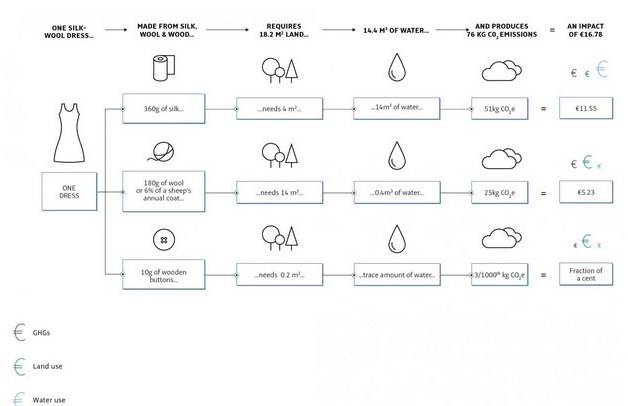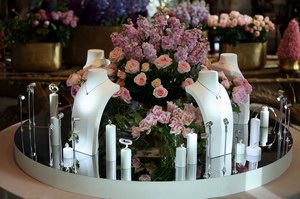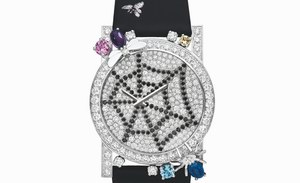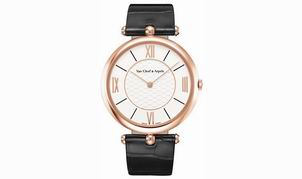Luxury fashion brands are going green. But why are they keeping it a secret?
文章导读
Luxury fashion brands are going green. But why are they keeping it a secret。The quiet changes at Kering and LVMH are laudable, experts say. But with its rapt audience of tastemakers and innovators — and its unique ability to create markets where none existed — luxury could do so much more.

Kering has started quantifying the environmental impact of its products. This chart estimates the amount of land and water used and the amount of carbon emissions required to produce the silk, wool and wood for one designer dress, and assigns a Euro value for each factor. (Kering/Courtesy of Kering from its 2014 Environmental Profit and Loss Report)
The Paris-based LVMH, which controls Louis Vuitton, Céline, Givenchy, Christian Dior and Fendi, among other luxury brands, began to focus on sustainable business practices in 1992 in its wine and spirits division. This fall, LVMH announced the creation of a carbon fund that each brand pays into based on its energy consumption. The approximately $5.3 million fund supports projects such as upgrades from traditional lighting to LED.
In June, Kering released its first Environmental Profit and Loss Report, examining where in its chain of more than 1,000 suppliers in 126 countries lurk the largest and gravest impacts on the environment. Looking at all its labels — from the silk T-shirts and motorcycle jackets of Saint Laurent to the sports gear of Puma — Kering measured water consumption, air pollution, greenhouse gas emissions and land use. It then translated these findings into euros to estimate how much the production of, say, a single leather handbag costs the environment: 11.85 euros last year, or about $12.53.
In 2013, Kering’s luxury goods cost the environment about $817 million. (A similar conglomerate, operating without environmental restraint, would have put a strain of $1.2 billion on the planet, according to PricewaterhouseCoopers.) In 2014, that environmental cost ticked upwards by 2.2 percent to $838 million — while revenue grew by 4.5 percent.

In this chart, Kering estimates the land and water usage and carbon emissions associated with producing the leather, brass and linen for one handbag. (Kering/Courtesy Kering, from the 2014 Environmental Profit and Loss Report)
Kering posted this data online so other manufacturers could learn from their lessons. “When you are speaking about sustainability, if you keep it all for you, you won’t change the paradigm,” says Marie-Claire Daveu, Kering’s chief sustainability officer.
The Kering report also revealed that only seven percent of the company’s environmental impact was at its boutiques, headquarters and warehouses. Fifty percent came from the production of raw materials. And 25 percent was from processing those materials. The most significant impact included the greenhouse gases from cattle ranching and the land and water dedicated to traditional sheep farming.
The goal is not to ban wool or leather but to find more environment-friendly ways to produce it. Kering and LVMH, for example, are moving away from traditional tanning methods that use chromium.
But bright candy colors typically cannot be produced without using heavy metals, says Sylvie Bénard, corporate environment director at LVMH. There’s also a concern with color stability. A customer can’t get caught in a rainstorm and find her handbag dripping dye onto her cashmere trousers. Gucci developed an organic tanning technique and in 2013, began using it to produce special-order, bamboo-handled bags. Louis Vuitton’s Gaia Monogram Cerise handbags now use vegetable-tanned leather.
关键词: Kering | LVMH | Gucci | Luxury brands | fashion brands
免责声明:
本文仅代表作者/企业观点,与【风尚中国】无关。其原创性以及文中陈述文字和内容未经本站证实,对本文以及其中全部或者部分内容、文字的真实性、完整性、及时性本站不作任何保证或承诺,仅供读者参考,并自行核实相关内容。
【风尚中国】刊载此文出于传递更多信息之目的,并不意味着赞同其观点或证实其描述,也不代表本网对其真实性负责。
如因作品内容、版权和其它问题需要同本网联系的,请在30日内进行;新闻纠错: edit#fengsung.com








